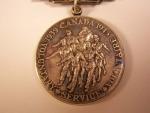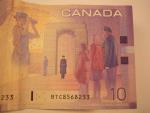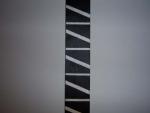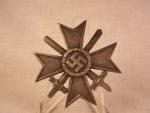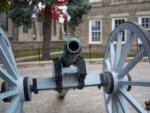-
Posts
6,486 -
Joined
-
Last visited
-
Days Won
10
Content Type
Profiles
Forums
Blogs
Gallery
Events
Store
Everything posted by Brian Wolfe
-
Hello Everyone, I just added this Canadian Volunteer Services Medal with Hong Kong bar to my collection this week and would like to share some information as to the identity of those actually shown on the obverse. The Canadian Volunteer Service Medal was awared for 18 month's voluntary service in the Canadian Froces from September 3, 1939 to March 1, 1947, 650,000 have been awarded. The Maple Leaf Bar (shown on this medal) was for overseas service, 525,500 bars awarded, and the other bar, The Hong Kong Bar (also with this medal) was for personnel involved in the Battle of Hong Kong from December 8 to 25, 1941, with 1,975 Canadian personnel involved in the defence of Hong Kong. The Hong Kong Bar was instituted on April 28 1994. I believe that both bars are original to this particular medal as I know the source of the medal, though I could not prove it beyond a shadow of a doubt and I don't have the supporting papers (yet). The patina and wear on the Hong Kong Bar is not quite as much as the rest of the medal yet shows wear and patina itself. In other words it is not a resent addition to bump up the value. Now to the matter of who is actually shown on the obverse. I have other Canadian Volunteer Service Medals some in mint condition but I wanted to show this one because of the Hong Kong Bar and the detail showed up better in my photographs. To quote the "Medal Year Book", "The seven marching personnel are based on real people taken from National Defence photographs, representing the land, sea and air forces plus a nurse. The individuals are: first row: centre,3780 Leading Seaman P.G. Colbeck, RCN; left, C52819 Pte D.E. Dolan, 1 Can. Para. Bn; right, R95505 F/Sgt K.M. Morgan, RCAF, Second row: centre, W4901 Wren P. Mathie, WRCNS; left, 12885 L/Cpl J.M. Dann, CWAC; right, W315563 LAW O. M. Salmon, RCAF; back row: Lt N/S E.M." Lowe, RCAMC. I hope this is not a repeat of someone else's past post, I looked and couldn't find one. Cheers Brian
-
Hello Everyone, I just ran onto this short story regarding the veteran that is pictured on the back of the Canadian Ten Dollar bill and wanted to share this with the membership especially as tomorrow is November 11. I was not sure where to post this so if I have erred I hope someone will move the post. A photo of the area of the ten dollar bill with this veteran follows the writeup. If you look at the back right-hand side of a Canadian $10 bill, you will see an old veteran standing at attention near the Ottawa War memorial. His name is Robert Metcalfe and he died last month at the age of 90. There are several good articals on the internet regarding this topic and it looks like everyone has "stolen" from an original as they are almost all identical. Rahter than add to the crime of the theft of someones else's work I will summarize. Born in England he joined the 400,000 members of the BEF in France and found themselves out numbered by the German forces. While he was tending to a wounded comrade he was hit in the legs by shrapnel. While he was being transported to the hospital by ambulance they came under fire from a German tank. He survived this to be evacuated from Dunkirk on the HMS Grenade, two of the sister ships to the Grenade were sunk. After he recovered he was sent to North Africa en route the ship he was chased by the German battleship, Bismark. After North Africa he served in Italy where he met and married his wife, a lieutenant and physiotherapist who was serving in a Canadian hospital. After the war they settled in Chatham, Ontario where he went into politics and became warden (chairman) of the county. On retirement he and his wife moved to Ottawa, Ontario and at the age of 80 wrote a book about his experiences. One day out of the blue he received a call from a government official asking him to go downtown for a photo session. He was not told why they wanted the photo and he had no idea he would be featured on the Canadian Ten Dollar Bill. I hope you liked the story. Cheers Brian
-
Hello Everyone, I am quite excited to have just added a Punjab Ribbon to my collection. The ribbon seems to be a plasticised cloth-like material with the black sections applied. The reverse side of the ribbon is white its manufacture being a lot like the High Altitude Medal Ribbon that I posted earlier. The Punjab Ribbon was awarded to security forces for service in "Operation Bluestar" in the Punjab, India. My research has also suggested that this ribbon was used on the Garaj Star awarded for "Operation Black Thunder". I was going to give a short history of these two operations but then thought better of it as I was worried that it could get political very quickly. You should take the time to go to Google, or whatever search engine you use, and type in Operation Bluestar and Operation Black Thunder for more information. It is a very interesting period of history. There is no medal that I am aware of for Operation Bluestar and there were only four Garaj Stars ever produced. The ribbon is seen on the undress ribbon bar and never as a suspension ribbon. Many thanks to Ed Haynes for all of his research, which I have stolen for this post without asking. For more information on the Punjab Ribbon see: http://haynese.winthrop.edu/india/medals/indmed.html For more on the Garja Star see the GMIC's section on South Asia: Militaria & History, type Garaj Star into the search area and away you go. Cheers Brian
-

Nice pair of old cannons from Perth Ontario
Brian Wolfe replied to Brian Wolfe's topic in Firearms & Ordnance
Hi Pylon1357, I hope you do take the time to stop in at Perth. These cannon are in front of the Lanark County Court House on Drummond Street. Your correct, the Town of Perth itself never had its own Regiment. Many of the fellows who joined up in WW I did so with the Peterborough Rangers. The Second World War saw many Lanark boys joining up in Cormwall Ontario with the Glengarry Fencibles of the Stormont Dundas & Glengarry Highlanders (SD&G). Their nic-name was Sand, Dirt and Gravel. By the way, it was a good thing that I posted these photos because I seem to have lost them from my computer. Oh well, I'll take more next year when I visit Perth again. Cheers Brian -
Hi Chesley, Ok, I'll hold off until I hear from other members. I'm new to collecting German and would usually stick to Imperial but this one came up at the end of a trade (fossils for medals) to make up the difference between what the dealer wanted and I "needed". It was this or an Imperial item but I already had the Imperial item so I settled for this. I hope it was not a mistake, though one I can rectify which is not something that is always possible. Thanks for your advice. Regards Brian
-
Hello Everyone, I just picked up this trio and wanted to show them off. It consistes of the EK II, Honour Cross w/swords and the Wilhelm Centennial Medal. From my research on this forum's past posts I was comfortable in closing the deal on this group as there is a similar trio posted and I at least knew it was a probable group. The mount is in the Prussian Parade style and the Centennial medal has lost its ring and was sewn back onto the ribbon, from the look of the thread used I would think it was reattached by the owner. Funny thing is that the way it was reattached allows the medal to show the reverse when in wear more easily than the obverse. That was probably an accident and I can imagine the soldier having to readjust the medal from time to time while he was wearing it. I would assume that this soldier was in the service of the Kaiser on or before 22 March,1897 and survived the First World War as he received the Honour Cross. The fact that he received the EK II and the Honour Cross w/ swords would mean that he saw serious action in the Great War. At least that is what I have gather from researching the forum. I hope you like it as much as I. I didn't show the reverse as it's pretty common. Cheers Brian
-
Here is the obverse and the mark in question. To the naked eye the "59" looks more like a "53" but under the glass it looks more like a "59". The other thing I am questioning is the attachment pin area looks to have been ground to accept the solder and it looks like it was done well after the medal was made. Lots to make me worry, but an I worried for no reason? Thanks again. Brian
-
Hello Everyone, I just got this War Service Cross w/ Swords and would like some opinions at to whether it is the real deal or sould I be concerned? The dealer I got this from is an honest enough guy but he deals in antiquities and only has a few medals as a side line. Anything he knows to be a reproduction is marked as such and priced accordingly. I have searched this forum and could not answer my concerns so I am hoping that you might be able to assist me. My concern is in the markings. They are not on the pin but on the obverse of the medal. Added to this the mark is not impressed into the medal but stands "proud" and was, it looks, part of a casting process rather than a struck medal. The mark is L/59 within a rectangle. If this is not a correct medal I am sure I can return it. Any help you can give me is greatly appreciated. Cheers Brian
-

SS BAYONET HELP
Brian Wolfe replied to Woton's topic in Germany: Third Reich: State, Civil, NSDAP Awards & Decorations
Hi Ben, I agree with Gordon. Back in the day when I was collecting bayonets I think I was one of the first to be taken in by these fakes. Ouch, right in the old pride. Now I collect medals.....hmmm......and I still get stung from time to time. Cheers Brian -

14-15 star
Brian Wolfe replied to Colin O.'s topic in Great Britain: Orders, Gallantry, Campaign Medals
There was a slip on bar as well offered by the tailors. One of my 1914 Stars (to a verified recipient) has this slip on style. The original bar must have been lost. Cheers Brian -
Hi William, Regarding your comment about 16 member looking at the post without any opinions. There may have been several like me who are just learning and as yet have no opinion. I offer this today as, believe it or not, I just obtained my first one today! Mine is the 1st class and I'm very excited to have gotten it. I will post it at a later date to get other's and hopefully your opinions. I'll also keep watching your post to gain as much knowledge as possible . Cheers Brian
-

Iraq Iran War Monument Captured Iranian Helmets
Brian Wolfe replied to a topic in Middle East & Arab States
I liked the post Lorenzo, thanks for sharing it. Just a word on the monument itself. It is not unlike many ancient monuments (eg. Ancient Egypt) showing the victory of the king and depicting the fallen enemy troups. I believe there are also similar carvings in Mezo America. Grim, yes but nothing new. Cheers Brian -
This is an interesting post and I have gained a lot of knowledge about the way the dollar and the market play out. Interesting, but it really is of little concern to me collecting wise. Not to belittle anything anyone has said but I collect what I can and when I can. The Canadian dollar has been up, then down now up again. I don't collect for investiment, I collect for my own enjoyment. If it costs more to enjoy myself so be it, I just collect a little less and not so often. Actually since the US dollar has been lower it seems I've added less from the US and more from the UK, go figure. You could say that a fool and his money are soon parted but what the heck 50 years from now will it really matter? Cheers Brian
-
Hello Adam, Congratulations! A nice badge indeed. You must be very happy to be adding it to your collection. Cheers Brian
-
Hi Kevin, The use may seen obvious to us today but from what I have been told by a former RCAF officer the practise was discouraged among the Canadian Bomber Command. Cutting the parachute lines was not considered as important as getting out of the water as the North Sea is, as you know, quite cold and the survival time is very limited. The use of a knife for survival didn't seem too important either though they did provide each Airman with a photo that could be used on a fake passport. This I find strange as why would you (as a government) provide means for the Resistance to make a fake passport and yet not arm the airmen. I can find no supporting documentation for my claim, I am only going by the word of several former RCAF crew. Actually a phoned my father to confirm this on the weekend. Another thing I find odd was that the Candaian Airforce installed a sort of hatchet tool near the wireless station on the Lancaster. The idea being that if you crashed and survived that, but were trapped inside the aircraft, you could chop your way out with this hatchet. I have seen these for sale at shows but never purchased one. When I asked my father and his crew members about this they said that they didn't even know there was one available and then more or less quoted their two rules for surviving a bomber crash. Rule one, survive the crash. Rule two, there is no rule two because you won't actually get past rule one. Somehow they found this quite amusing. Cheers Brian
-
Hi Fellows, Nice bayonets, you make me wish I had not sold my Japanese bayonet collection. Here is some information I have from Larry Johnson's book, "Japanese Bayonets", Cedar Ridge Publications, Broken Arrow, Oklahoma. Dan's bayonet looks to be the Type 30 variation "A". The mark is that of the Koishikawa (Tokyo) 1870 to 1929 - 35, and Kokura Arsenal 1929-35 to 1945. After an earthquake in 1923, along with production streamlining of the armaments industries, production shifted from Toyko to the Kokura Army arsenal during the 1929-35 period. The mark is reported to represent four cannonballs in a pile, viewed from the top. Joel's looks to be the Type 30 but the "B" variation. The marks are those of the Nagoya Arsenal but the actual manufacturer is unknown. This mark has also been referred to as Atsuta, which was a factory in the Nagoya arsenal system. It is often referred to as the Nagoya diamond mark. As to the hook I have always held that, like the British bayonet of WWI, they started out with a hooked quillion but was modified to allow easier and faster production. The book "Japanese Bayonets" has this to say about the subject. "The hook is believed to have been discontinued in the late 1930s or early 1940s. The hook was no longer popular in many countries and it may also have been eliminated to simplify production". The bayonet was indeed a major part of the military thinking and had its roots in the samurai code of Bushido which said the the honorable way to meet the enemy was face to face. Japanese soldiers were trained on the range to fire their weapons with bayonets affixed to the rifle which was not the general rule for other nations. I hope this is of some help. (Man, I miss my boynets) Cheers Brian
-
Very nice blades. Thanks for sharing them. Cheers Brian
-
Hi Johnsy, That's the photo I was talking about. I was writing my post while my wife was trying to get me out of the house to visit her family. I wanted to scan that photo but though better of it when she went out and actually started the car and sounded the horn. I know when I've pushed the issue too far and this was one of those times. Thanks for posting it. That's an interesting mark on the knife. Luftwaffe you say? That's interesting. I've seen Lftwaffe weapons before but, I have been told that Canadian Airmen, and I would suspect, British as well were discouraged from carrying weapon. This is Bomber Command, Fighter Command may have been different. The theory was that if shot down and captured they (the Germans) would go easier on you if you were unarmed. Many purchased weapons privately and had them with them while on missions. My father once said that they were not really sure what they would have done with these weapons if shot down but it gave them a feeling of security while on their missions. Cheers Brian
-

Nice pair of old cannons from Perth Ontario
Brian Wolfe replied to Brian Wolfe's topic in Firearms & Ordnance
Thanks for the information fellows. I intend to research these cannons more deeply as time goes on. Peter, isn't the Perth Regiment out of the Stratford area? That's situated right next door to where I now live while Perth (the municipality) is south of Ottawa in Lanark County. As I find out more about these pieces I'll share it on the forum as well as the Perth Museum and Archives. Thanks again for all of your help. Cheers Brian -
Hello bsweeney, I believe what you have is a Nahkampfmesser knife of the stlye produced after 1935. This is a lot like the WW I knives but the scabbard has a steel spring clip for attachment to the belt or on the side of the boot, this was not a feature of the WW I knives. From the name I guess it is obvious that it is a German knife. There is a famous photo showing a Waffen- SS soldier with one of these types projecting from the lapel of his motoring coat. Frederick J. Stephens' book "Fighting Knives, An Illustrated Guide to Fighting Knives and Military Survival Weapons of the World" , Arms and Armour Press, Fortress Publications, Ontario is a good source of information on these and other fighting knives. By the way, great specimen. Cheers Brian
-

Nice pair of old cannons from Perth Ontario
Brian Wolfe replied to Brian Wolfe's topic in Firearms & Ordnance
This is the business end with the Court House behind. The smooth bore measured 3 inches in dia. There were some cannon balls welded together and chained down on the ground, they may be in one of the photos but I didn't bother to show them on their own as a cannon ball is a cannon ball, especially if it is covered with rust. I hope you liked my photos and if you are ever in Perth check these out. Cheers Brian



